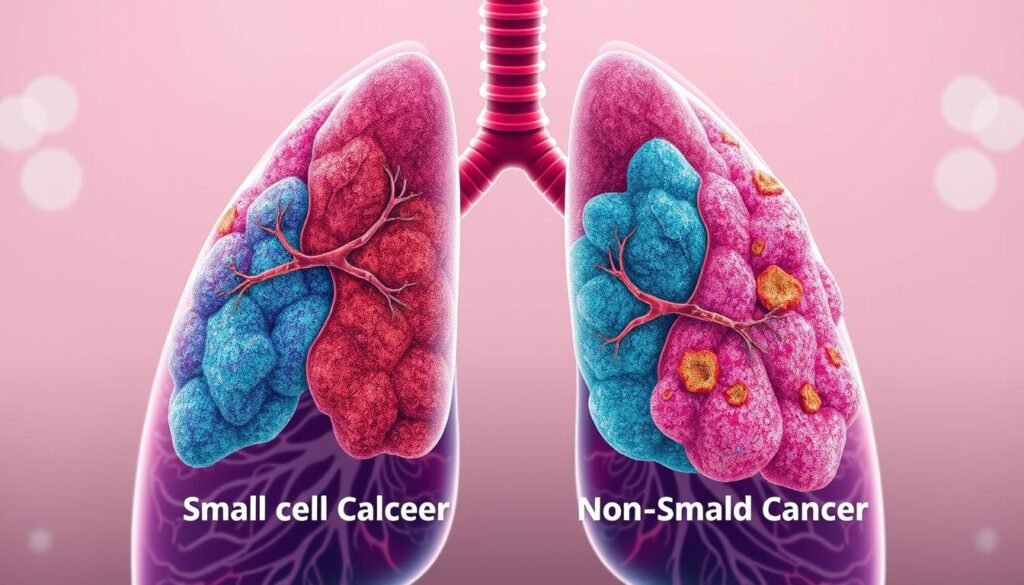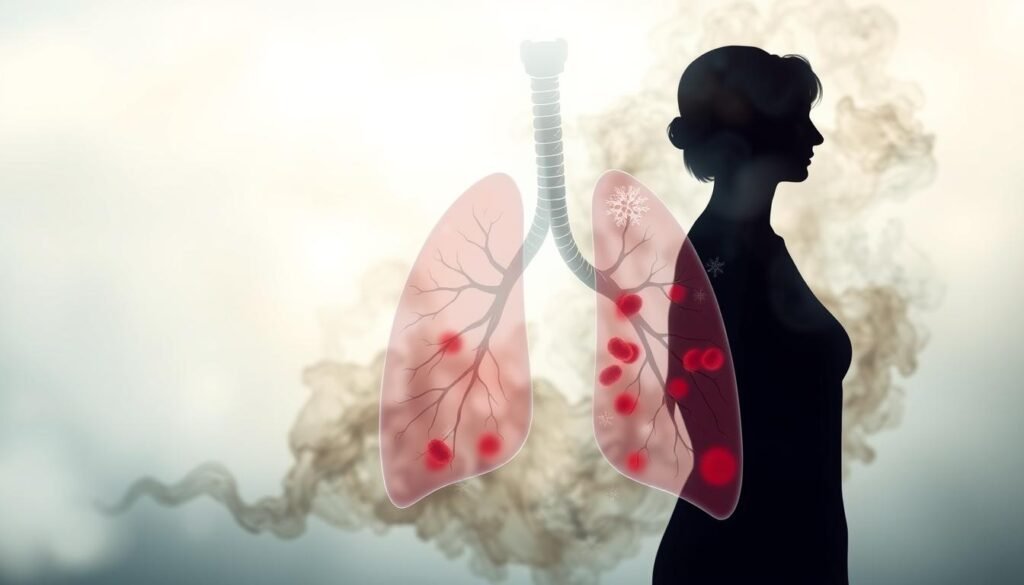Lung cancer ranks as the third most common major cancer in the nation. It follows breast cancer in women and prostate cancer in men. Each year, about 235,000 new cases are found in the U.S. This shows how crucial it is to learn about lung cancer and lymphoma. These diseases are not just big health issues in America. They also greatly affect the respiratory system of millions.
We wrote this article to give you an overview of lung cancer and lymphoma. You will learn about their types, signs, and ways to treat them. Lung cancer causes many cancer-related deaths. So, knowing about its types like Non-Small Cell Lung Cancer and Small Cell Lung Cancer is key to handle and stop it. Also, if you have had lymphoma, your chance of getting lung cancer goes up. This fact is very important for doctors who treat chest illnesses.
Knowing symptoms such as a long-lasting cough, feeling short of breath, and tiredness is vital. This knowledge can help in finding and treating the diseases early. Organizations like the American Cancer Society and American Lung offer great help to those in need. Now, let’s learn more about the complex nature of lung cancer and lymphoma. We will improve our understanding of these tough health issues.
Key Takeaways
- Lung cancer is the third most common cancer in the U.S., with 235,000 new cases diagnosed annually.
- There is a significant link between smoking and lung cancer, accounting for up to 90% of cases.
- Over two-thirds of lung cancer patients are diagnosed at age 65 or older.
- Non-Small Cell Lung Cancer constitutes 85-90% of all lung cancer cases.
- Lymphoma survivors have a heightened risk for developing lung cancer.
- Timely awareness of symptoms is essential for effective treatment.
- Organizations like the American Lung Association offer resources and support for those affected.
Introduction to Lung Cancer
Lung cancer is a major health issue due to abnormal cell growth in the lungs. This leads to tumors that hurt lung function. The National Cancer Institute reports about 235,000 new cases each year in the US. Knowing the symptoms of lung cancer is key for early finding and better treatment results.
Lifestyle and environment mainly affect lung cancer risk. Smoking causes around 90% of cases, showing how vital prevention is. Secondhand smoke and pollution also raise the risk. It’s important to be aware of lung cancer signs for early detection. Early signs may include:
- Persistent cough
- Chest pain
- Unexplained fatigue
These signs should make people seek medical help. Early detection and treatment can start this way. Knowing what leads to lung cancer and its signs helps people manage their health better.
Types of Lung Cancer
Lung cancer includes two main types: non-small cell and small cell lung cancer. Knowing about these helps understand their different traits, treatments, and outcomes.
Non-Small Cell Lung Cancer
Non-small cell lung cancer (NSCLC) makes up about 85-90% of lung cancers in the U.S. It has several subtypes, each with its own features and stats:
- Adenocarcinoma: This is the most common type, making up 30% of all lung cancers and 40% of NSCLC cases.
- Squamous Cell Carcinoma: Makes up around 30% of NSCLC and is mainly linked to smoking. It usually starts in the central airways.
- Large Cell Carcinoma: This counts for 10-15% of NSCLC and can be more aggressive.
There are also rarer lung tumor types, like carcinoids, making up 1-2% of lung cancer cases. Of these, typical carcinoids are most common.
Visit this resource for more on non-small cell lung cancer types.
Small Cell Lung Cancer
Small cell lung cancer (SCLC) is rarer, being 10-15% of cases. It’s aggressive and mostly linked to heavy smoking. It has two stages:
- Limited Stage: Cancer hasn’t spread much and can be treated more effectively.
- Extensive Stage: Cancer has spread, making treatment harder and prognosis worse.
It’s crucial to understand the growth and treatment differences between SCLC and NSCLC. This knowledge helps in treating patients effectively.

Understanding Lymphoma
Lymphoma is cancer that targets the lymphatic system, an essential part of the immune system. There are two main types of lymphoma: Hodgkin lymphoma and non-Hodgkin lymphoma (NHL). They differ in their traits and how doctors treat them.
About 81,000 new non-Hodgkin lymphoma cases are found each year in the U.S. Today, approximately 808,000 Americans are living with NHL. In contrast, Hodgkin lymphoma is less common. It has about 9,000 new cases yearly, affecting around 228,000 people nationwide.
It’s vital to spot lymphoma symptoms early. They can be as mild as swollen lymph nodes or as severe as fever and night sweats. Factors like autoimmune diseases, certain infections, and genetics can increase lymphoma risk. For example, B-cell lymphoma makes up about 90% of NHL cases. Meanwhile, T-cell lymphoma represents around 10%.

Non-Hodgkin lymphoma is either aggressive or indolent. Aggressive forms like Burkitt lymphoma hit hard and fast, making up about 60% of NHL cases. Indolent types, such as follicular lymphoma, grow more slowly.
Most Hodgkin lymphoma cases belong to the classical type, around 95%. This group includes various subtypes, like nodular sclerosis. The outlook for lymphoma patients depends a lot on the lymphoma type, how early it’s found, and their overall health. For instance, the five-year survival rate for NHL is 74%, but it rises to 87% if the cancer is caught early.
Treatments for lymphoma include chemotherapy, radiotherapy, and targeted therapies. Joining clinical trials lets patients try new treatments. This is important for improving lymphoma care.
The Relationship between Lung Cancer and Lymphoma
Lymphoma survivors face a higher risk of lung cancer. This risk stems from lymphoma treatment, including chemotherapy and radiation. These treatments can make lung tissue more likely to turn cancerous. Also, if a survivor smoked, their risk gets even higher. Thus, it’s vital for these survivors to get regular lung cancer checks.
Risk Factors for Lung Cancer in Lymphoma Survivors
About 79% of lymphoma survivors who get lung cancer are diagnosed five years after beating lymphoma. Many of these survivors smoked, with some studies showing rates as high as 87%. Smoking is a big risk factor in this group. Non-Hodgkin lymphoma, especially the follicular subtype, is the most common lymphoma linked with lung cancer.
Prognosis and Treatment Options
The outlook for lung cancer in lymphoma survivors depends on the lymphoma’s activity. Those with non-active lymphoma have a median survival of 64 months. But it’s 37 months for those with active lymphoma. When it comes to treatment, surgery is a common option. Out of 164 patients in a study, 145 had surgery and showed better survival rates.
Early detection of lung cancer leads to better chances of recovery. Finding cancer early, especially during routine checks, can significantly boost survival.

| Factor | Impact on Survival |
|---|---|
| No-active lymphoma | 64 months median survival |
| Active lymphoma | 37 months median survival |
| Early lung cancer stage | 70% five-year survival for stage I |
| Advanced lung cancer stage | 12 months median survival for advanced cases |
Looking into advanced methods like the lung cancer blood can reveal cancers early. Early diagnosis is key. It makes treatment more effective and improves chances for lymphoma survivors with lung cancer.
Diagnosis of Lung Cancer and Lymphoma
Doctors use lung cancer diagnosis and lymphoma diagnosis to find out if someone has cancer. They look at the patient’s medical past and use exams and imaging. CT scans, chest X-rays, and MRI are some tools they use to see if cancer is present and tell lung cancer from lymphoma.
Images are key to understanding lung cancer’s stage and spread. CT scans show how big and where tumors are. PET scans check if the cancer has moved, especially if the tumor is larger than 8 mm.
When someone has lung problems, doctors might use ultrasound. This helps find fluid near the lungs or helps during biopsy.
For biopsy, a method called fine needle aspiration (FNA) is used to collect tissue. In lung cancer, testing for certain markers helps pick the best treatment. For example, the EGFR test helps find the right therapy. About 4% of non-small cell lung cancer (NSCLC) patients have ALK gene changes and need specific tests.
Lymphoma diagnosis also depends on imaging, like CT scans and MRI. To check for cancer in lymph nodes, doctors often do biopsies. A complete blood count (CBC) helps understand the patient’s overall health before starting treatment.
Quick and accurate diagnosis makes treating lung cancer and lymphoma more effective. Early detection greatly increases the chance of successful treatment.
| Diagnostic Method | Application in Lung Cancer | Application in Lymphoma |
|---|---|---|
| CT Scan | Identifies tumor size, shape, and location | Assesses lymph node involvement |
| PET Scan | Evaluates spread of cancer | Helps in staging and response to treatment |
| MRI | Checks for metastasis, especially in the brain | Assesses involvement of central nervous system |
| Ultrasound | Guides biopsies, identifies fluid buildup | Used in evaluation of enlarged lymph nodes |
| Biopsy (FNA) | Confirms lung cancer diagnosis | Confirms lymphoma presence |
Treatment Options for Lung Cancer
Lung cancer treatments differ greatly based on cancer stage and type. Understanding all treatment options is key to picking the best approach. Treatments like surgery, chemotherapy, and radiation can be used alone or together, depending on the diagnosis.
Surgery
For non-small cell lung cancer (NSCLC) that’s localized, surgery is often the first step. If caught at stage 0, surgery alone might cure it. When it reaches stage I, surgeries like lobectomy are advised, sometimes with additional treatments like chemotherapy and immunotherapy to lower recurrence chances.
Chemotherapy
Chemotherapy is crucial in lung cancer treatment, often after surgery or with other therapies. Stage II patients might get chemotherapy before surgery to shrink the tumor. This makes surgeries like lobectomy or pneumonectomy possible. Chemotherapy is also vital for removing cancer cells left after surgery.
Radiation Therapy
Radiation therapy is key for both curing and palliative care in lung cancer. Advanced stage patients may have radiation before surgery to help with the operation, especially if cancer has spread in the chest. Stereotactic body radiotherapy is precise, great for patients who can’t have surgery.
| Treatment Option | Stage of NSCLC | Purpose |
|---|---|---|
| Surgery | Stage 0 | Cure without further treatment |
| Surgery | Stage I | Lobectomy or resection with adjuvant chemotherapy |
| Chemotherapy | Stage II | Neoadjuvant before surgery or adjuvant post-surgery |
| Radiation Therapy | Stage III | Used in combination with chemotherapy or alone for palliative care |
| Stereotactic Body Radiotherapy | Advanced Stage | Focused treatment for small inoperable tumors |
Looking at all lung cancer treatment options helps patients find the best therapies for improved outcomes. Knowing about treatments like surgery, chemotherapy, and radiation therapy lets patients and caregivers make informed choices suited to their specific needs and situations.
Living with Lung Cancer and Lymphoma
Living with lung cancer or lymphoma is tough. It affects your emotions and body in big ways. People with these illnesses feel a lot of stress about treatment and what comes next. Having strong support from loved ones and medical teams is key.
For lung cancer patients, managing symptoms is crucial. Talking regularly with doctors about how treatment feels is important. This helps make health better over time. In fact, about 65% of people with early lung cancer live five years or more.
Lymphoma survivors face their own challenges, like higher risks for other cancers. Places like the Lymphoma Survivorship Clinic at MSK are there to help. They check for heart disease and new cancers, making sure survivors stay healthy.
Educational efforts are improving lung cancer awareness among lymphoma survivors. Routine screenings can catch lung cancer early, when it’s easier to treat. A study showed screening lymphoma survivors can find lung cancer sooner, which really helps.
Having cancer doesn’t stop you from reaching your dreams. Many survivors live rich, full lives after treatment. Being active in your care, joining support groups, and seeking information builds community. This proactive approach helps you live well after cancer. For tips on after-care, check out these resources.
| Stage of Lung Cancer | 5-Year Survival Rate |
|---|---|
| Stage 1 | 65% |
| Stage 2 | 40% |
| Stage 3 | 15% |
| Stage 4 | 5% |
As a community, we can help each other through lung cancer and lymphoma. Focusing on support, learning, and health checks makes a huge difference. Survivors can move forward with hope, armed with resources to live better lives.
Conclusion
Understanding lung cancer and lymphoma is very important for patient care. Lung cancer often gets diagnosed late, making early symptom recognition vital. If you notice a persistent cough, chest pain, or changes in your health, see a doctor right away.
Advances in treatments, especially immunotherapies, are helping patients live longer, better lives. Research on new drugs like pembrolizumab is creating exciting treatment possibilities. It’s crucial to find these cancers early to improve survival chances.
There is real hope for patients and their families. Stay informed about your health and speak up about your needs. Watching for swollen lymph nodes in the neck can be key. For tips on spotting early warning signs, check out early detection resources. With ongoing research and awareness, we can aim for more positive journeys through these illnesses.